Mastering Grill Pan Vegetables: Quick Techniques & Recipes
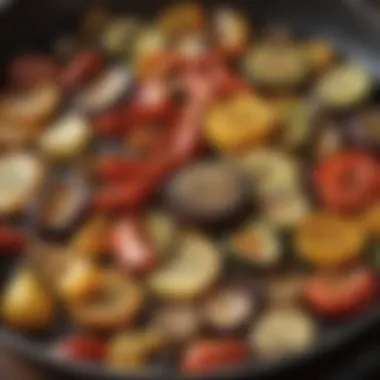
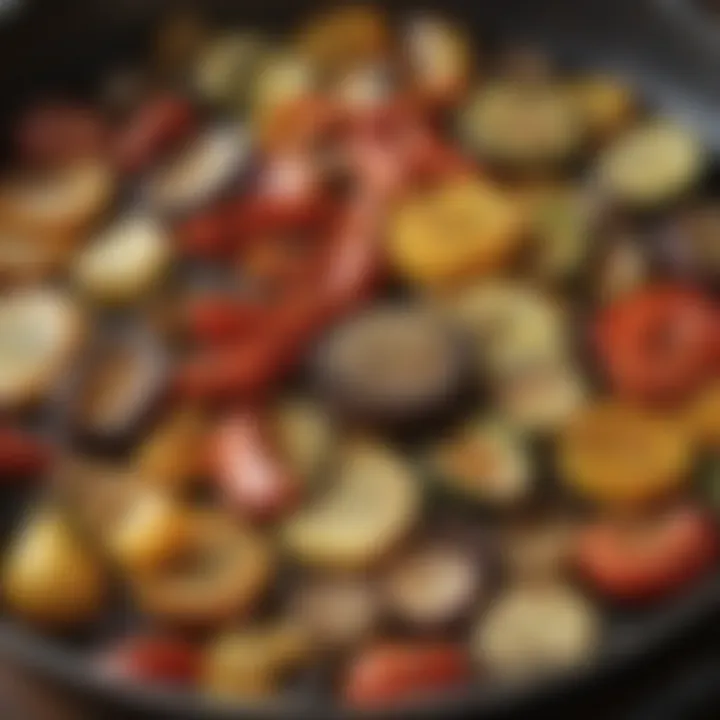
Intro
Cooking vegetables in a grill pan can turn a simple dish into an appealing one. This method empowers busy individuals to prepare wholesome meals with ease. As modern life demands, effective use of time in the kitchen is crucial. Understanding the advantages of grill pan cooking will streamline meal preparation.
When vegetables hit the grill pan, their flavors intensify, leading to robust and delicious results. Incipping the natural tastes brings enjoyment without overwhelming ingredients or technique. Efficient cooking techniques will be outlined to simplify the process and avoid mishaps that can occur due to rushed actions. From recommended vegetables to tasty meal suggestions, this guide serves as a complete resource for anyone looking to use grill pans in countless dining options.
Key principles of this cooking method will be supported with practical recipes and invaluable tips for execution. Discover how to select ingredients, implement straightforward steps, and discover alternatives suited for your dietary preferences. Your ability to whip up satisfying meals will not rely on extensive time spending.
The aim here is clear: enhance your kitchen skills and make grilling vegetables a matter of habit without major disruptions to the busy lifestyle.
Recipe Highlight
Let’s start with a dish that is both vibrant and nourishing: Grilled Vegetable Medley. This dish brings together the best summer vegetables, resulting in an easy, yet comprehensive meal.
Essential Ingredients:
- Zucchini
- Bell peppers, assorted colors
- Red onion
- Olive oil
- Salt and pepper
- Optional: balsamic vinegar for drizzling
Preparation Time: Approximately 20 minutes.
Servings: This recipe yields four servings.
Step-by-Step Instructions
- Start by washing and cutting all vegetables into thick slices. This helps them hold together during grilling.
- In a bowl, combine your veggies. Drizzle garlic-infused olive oil over them and seasoning with salt and pepper to preference. Mix at all evenly.
- Heat your grill pan over medium heat until almost smoking.
- Place the vegetables in the pan, ensuring they don’t overlap too much.
- Grill until you see grill marks, about 5-6 minutes per side. Careful flipping will help show the nice look and avoid breakups.
- Once charred to liking, remove from the heat.
- If desired, add a drizzle of balsamic vinegar before serving.
Insider Advice: Using a grilling weight can enhance the cooking results while avoid flipping over. Also check the doneness by taste instead rely too much on time. This enjoy borne from the texture has words must matched with ambitions.
Variations and Substitutions
Feel free to play with the vegetable selection: carrots, asparagus, or mushrooms work too. Similarly, for those watching fats, skip the oil. You can substitute with vegetable broth to maintain flavor while observed dietary limits. Different seasonings like garlic powder or paprika can also add a local enrichment to warmth the mix.
Everything does not need to amaze sides of any challenging contribution. Paired alongside grilled chicken may generate a fulfilling main course or can serve directly atop quinoa for a vegetarian treat.
Time-Saving Cooking Tips
Prep ingredients ahead. Cleaning vegetables and slicing can be executed one day earlier. Arranging vegetables the day of enhances efficiency. Even so, good containers assist in keep cut pieces fresh. Famous gadgets like mandolins speed-up slicing.
For bulk cooking, consider oven roasting potatoes and other raw ingredients to save time later. Batch cooking of several selections allows for more restaurant-like food at home without demands on limited daily times.
Nutritional Information
Each serving roughly holds 100 calories. Rich in fiber and low in sugars makes it easy for choices suited for varieties of dietary plates particularly sustainable diets free of gluten. Vitamin C rank their physiologic benefits lead too therefore many will weigh such interests highly.
Remarkable nutrition makes eating enjoyable, yet practical at the same time. Consistent incorporation of vegetables not only adds creativity to plates but nurtures overall health at every stage of flavored meal planning.
Prelude to Grill Pan Cooking
Grill pans offer a practical means to elevate the everyday act of preparing vegetables into a dining experience that resonates with flavor and satisfaction. In our fast-paced world, lone individuals or working families may struggle to prepare wholesome meals. The grill pan enables these cooks to navigate meal prep efficiently without sacrificing taste or nutrition.
Historical Overview of Grill Pans
The grill pan is not a modern invention. Its origins can be traced as far back as ancient civilizations that utilized gravity and woodfire to cook over flame. Early versions resembled various forms of flat-top cooking surfaces. The transition to cookware designed explicitly for indoor cooking happened in the 20th century, fully realizing its versatility. Grill pans gained traction as people began to appreciate their capacity to reproduce grill marks and distinct flavors even while cooking indoors. From cast iron designs to non-stick materials, modern grill pans reflect the evolving needs of cooks seeking convenience and efficiency in the kitchen.
Why Choose a Grill Pan for Vegetables
There are numerous reasons why a grill pan becomes a favored tool for cooking vegetables. First, it ensures even heating, important for achieving that desired char and smokiness, reminiscent of outdoor grilling. Second, its ridged bottom helps fats and excess moisture drain away. As a result, vegetables emerge with a perfect texture: tender yet slightly crisp.
When opting for a grill pan, consider how versatile it can be. You can prepare a range of vegetables, from zucchinis to bell peppers, using minimal oil while still generating rich flavors. Ultimately, investing in a good grill pan is a proactive move towards healthier cooking habits, merging tradition with modern culinary efficiency.
"Grill pans simplify the botanical essence of vegetables, coaxing out intense flavors that busy cooks often desire."
Getting Started: Selecting the Right Grill Pan
Selecting the appropriate grill pan is crucial to achieving excellent results when cooking vegetables. A quality grill pan provides the right environment for grilling, ensuring that flavors and textures are optimized. Furthermore, the decisions you make regarding materials and dimensions affect ease of use and overall cooking experience. Having the right grill pan reduces cooking times and improves efficiency, which is vital for busy cooks.
Material Considerations
When choosing a grill pan, the material plays acritical role in influencing the cooking performance. While several materials are available, each has unique characteristics that can benefit different cooking styles.
- Cast Iron: Known for its excellent heat retention and even heat distribution, cast iron grill pans are ideal for achieving those desirable sear marks. They are durable and can last a lifetime, provided they are well cared for. However, they require pre-seasoning and can be heavy to handle, especially when flipped.
- Non-stick Coated Pans: These grill pans are often lighter and easier to clean. The non-stick surface ensures that vegetables can easily be lifted off without breaking apart. However, they may not withstand high heat levels as well as cast iron and could ultimately produce less depth of flavor.
- Stainless Steel: A versatile option, stainless steel pans are inert and do not react with food. However, achieving and retaining high heat can be a challenge. A bit of oil is needed to reduce sticking, and without a non-stick surface, careful attention to cooking times is important.
Choosing your grill pan material affects both the flavor outcome and the practicality of cooking. When you're a busy cook, understanding these distinctions can save both time and effort in the kitchen.
Size and Shape
The size and shape of your grill pan can also dictate your grilling success, especially how you can fit the vegetables. A larger pan accommodates multiple portions, making it advantageous for family meals or batch cooking. A well-chosen grilling surface also allows for even cooking.
- Shape: Square or rectangular pans maximize surface area and make flipping and arranging vegetables straightforward. Round pans tend to have a smaller cooking area and may complicate the grilling of multiple ingredients.
- Size: If you frequently cook for multiple servings or plan to grill larger vegetables like eggplant and zucchini, opt for a pan that can handle more food at once without overcrowding. Conversely, if you often cook for one or two, a smaller pan may suffice, reducing appliance size and cleanup time.
Understanding what material, size, and shape best fit the meals you cook will enhance your experience while making grill pan vegetables. Selecting the right grill pans transforms how busy cooks can prepare delicious, healthy dishes in less time.
Essential Vegetables for the Grill Pan
Understanding which vegetables are best suited for grill pan cooking is essential. This knowledge can greatly enhance the cooking experience and results. Grilling emphasizes natural flavors, and selecting the right vegetables is critical for optimal taste. They can transform a simple dish into something more vibrant and appetizing, making them crucial in this guide. When busy cooks recognize the important attributes of certain vegetables, meals become not just quick but enjoyable too.
Best Practices for Vegetable Selection
Selecting the right vegetables can make or break your dish. Here are practical points to consider:
- Freshness: Always choose fresh produce. Look for glossy, vibrant colors. Wilted or dull vegetables indicate age, affecting taste.
- Seasonality: Use seasonal vegetables to maximize flavors and cost-efficiency. For example, zucchinis and bell peppers shine in summer months, while root vegetables are exceptional in colder seasons.
- Size and Uniformity: Choose vegetables of similar sizes for even cooking. Cut large ones into uniform pieces to match smaller items.
- Texture: Tender vegetables, like asparagus and bell peppers, cook differently than denser ones, like carrots and potatoes. Knowing this helps in planning.

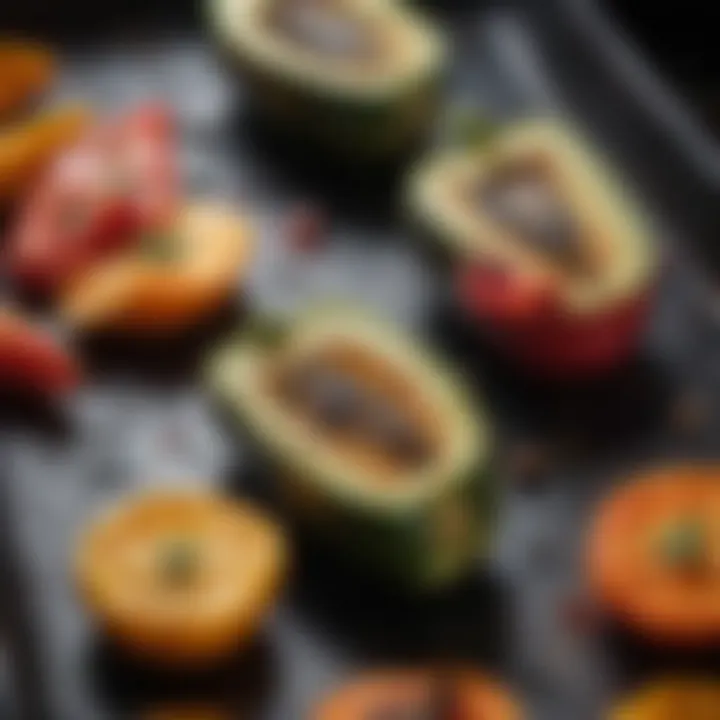
It's important to remember these practices when selecting vegetables for grilling. Proper selection simplifies cooking efforts.
Top Vegetables for Grilling
Some vegetables naturally lend themselves to grilling. Here are some top picks that suit grill pans extremely well:
- Zucchini: Its high moisture content helps in achieving nice grill marks without drying out.
- Bell Peppers: They provide a colorful vibrancy, sweet tang, and char beautifully when grilled.
- Eggplant: When sliced, it soaks marinade well. Grilling it enhances its naturally rich flavor.
- Asparagus: Quick to cook, asparagus maintains its texture while softening slightly;
- Mushrooms: Their earthy flavor transforms on high heat, offering an umami essence.
- Onions: Grilling intensifies their sweetness, making them an excellent option in various dishes.
These vegetables not only complement each other but also provide unique tastes and textures that elevate meals effortlessly.
Remember: Investing time in selecting and preparing vegetables boosts simplicity in your overall cooking process. Getting it right ensures a fulfilling meal with every serving.
Preparation Techniques for Grill Pan Vegetables
Preparation techniques for grill pan vegetables are essential. They influence the final taste and texture of the vegetables. Adding a touch of seasoning or finding the right cut can significantly enhance the flavor during cooking. Time management is key for busy cooks. Knowing how to prepare vegetables quickly and effectively can save precious time.
Cutting and Slicing
Cutting and slicing are among the most fundamental skills in cooking. When preparing vegetables for grilling, size and shape matter. Uniform cutting ensures that vegetables cook at the same rate. Thin slices often cook faster, while thicker cuts can provide a satisfying crunch. Grilling creates a smoky flavor, but proper preparation aids in consistent results on the grill. Here are some practical strategies:
- Consistent Shapes: For even cooking, aim for uniform sizes. Chunks of bell peppers, zucchini, or mushrooms should be similar in thickness. This consistency prevents overcooking or undercooking any specific piece.
- Consider Thickness: Large chunks may require longer cooking time. Cutting them too small can lead to charred or burnt bits. Find a balance that suits your cooking style and tastes.
- Angle Cuts: If you prefer to be creative, consider angled cuts for visual appeal. This technique helps release more surface area for better direct contact with the grill, enhancing flavor.
Marinating for Enhanced Flavor
Marinating is not only about imparting flavor; it's also helpful for tenderising vegetables, especially those that are more fibrous. The basic idea is to infuse moisture and additional seasoning into veggies before grilling. Here are some aspects to consider for effective marination:
- Duration: Depending on the type of vegetable, marinating times can vary. Leafy greens only need a brief soak, while sturdier options like carrots may benefit from longer marinating—up to an hour
- Choosing Ingredients: Common marinade components include olive oil, vinegar, and various herbs. Aim for a blend that enhances the vegetable's folder taste. Garlic, lemon juice, or balsamic reductions can create diverse flavor profiles.
- Temperature: Consider the marinading temperature. Marinating in the fridge prolongs flavor absorption. For quicker flavor infusion, leave vegetables at room temperature for 15-30 minutes before cooking.
Effective preparation must consider practical terms. Cutting, slicing, and marinating simplify the cooking process while enhancing flavor.
In summary, mastering preparation techniques for grill pan vegetables can enhance both flavor and experience. With these insights, busy cooks can make informed decisions and achieve optimal results in less time.
Cooking Methods: Maximizing Flavor and Texture
Understanding the cooking methods for grilling vegetables in a grill pan is essential. It affects not only the final taste but also the texture of your dishes. This section focuses on how different techniques can elevate your vegetable cooking experience and create dishes that are both visually appealing and flavorful.
Cooking methods play a crucial role in bringing out the natural flavors of vegetables. Employing the right techniques allows for enhanced caramelization, appealing char marks, and improved overall taste. Busy cooks will appreciate these methods, as they provide ways to maximize efficiency without compromising quality.
Preheating the Grill Pan
Preheating the grill pan is a critical step that should not be overlooked. Doing so ensures that the pan reaches the right temperature for cooking. A properly heated grill pan creates those coveted grill marks and allows for optimal even cooking. If the pan is not heated sufficiently, vegetables may become soggy instead of getting that satisfying texture.
Make sure to preheat on medium-high heat for about five to ten minutes. This will allow the grill lines to develop and improves the vegetables' ability to sear correctly. To test if it’s ready, you can use a few drops of water—if they dance around and evaporate quickly, the pan is ready.
The Art of Grilling Vegetables Evenly
Grilling vegetables evenly can be tricky, yet it is fundamental for delivering consistently cooked dishes. The shape and cut of vegetables matter significantly. Cutting vegetables uniformly, preferably to about the same thickness, allows for even exposure to heat and facilitates consistent cooking.
Rotate the vegetables as they grill to increase charring and flavor development. For instance:
- Place thicker items like zucchini pieces or bell pepper strips spaced out.
- Smaller items, like asparagus or cherry tomatoes, may need a grill basket.
Consider using a combination of vertical and horizontal placements—it's a valuable technique. Tilting thicker vegetables can help them cook through while maintaining an unburned outer layer.
Controlling Cook Time for Optimal Results
Awareness of cooking times contributes greatly to the success of your dish. Each vegetable requires a different duration to cook correctly. For example:
- Bell peppers may need around six to eight minutes.
- Thick slices of eggplant could take twelve minutes or more.
- Tender veggies such as zucchini can cook in around four to six minutes.
To achieve your desired level of doneness without making the vegetables tough, keep checking frequently. Additionally, you can remove vegetables when they reach a stage slightly undercooked if they will continue cooking after being taken off the heat.
Pre-cooked components can also be added at the end to create a harmony of flavors without compromising freshness.
Monitoring cooking times with a kitchen timer can aid in ensuring all vegetables emerge succulent and soft in texture. Affording attention to these methods elevates grilled vegetables from mere side dishes to central features on your table.
Flavoring Options for Grill Pan Vegetables
Flavoring is a pivotal aspect in grilling vegetables, enhancing taste and elevating the dining experience. For busy cooks, investing a little time in the right flavoring options can significantly transform a simple dish into a memorable meal. This section discusses the key elements that define excellent flavoring choices, particularly herbs, spices, oils, and dressings.
Herbs and Spices
Herbs and spices serve as the backbone of flavoring for grill pan vegetables. Their role is multi-faceted; not only do they add taste, but they also contribute to aroma and visual appeal. Fresh herbs like basil, cilantro, and rosemary provide distinct profiles that work harmoniously with grilled veggies. For instance, oregano enhances the flavor of summertime vegetables like zucchini and bell peppers. When choosing herbs, consider the cooking time. Delicate herbs should be added towards the end of cooking to prevent them from burning, while sturdier herbs can be mixed during the initial cooking phase.
Spices are equally vital. Cumin, paprika, and red pepper flakes can introduce heat and depth, making grilled vegetables more robust and exciting. Additionally, certain spice blends like Italian seasoning or curry powder encapsulate a variety of flavors, simplifying the seasoning process for busy cooks. The tactile act of mixing spices beforehand in a small bowl can create a quick yet efficient prep step without overwhelming the cook.
Using various herbs and spices not only increases flavor but allows the cook to personalize each dish according to preferences.
Quick Tips:
- Experiment with fresh vs. dried herbs for varied flavor intensity.
- Pair spices according to || vegetable type for elements of contrast.
- Use silicone brushes to evenly apply oils and spice mixes.
Incorporating Oils and Dressings
Oils are essential not merely for cooking but also for flavor enhancement. They create a base that helps adhere herbs and spices to the vegetables effectively. Selecting the right oil can significantly influence overall flavor. Extras such as olive oil, avocado oil, and sesame oil can augment a grill pan's heating potential and provide taste elements unique to each oil. For example, olive oil gives a classic flavor profile that complements almost every veggie. Friom technical significance, ensuring oils are heated properly can aid in achieving that a beautiful char, contributing to a dish's visual and oriented appeal.
Dressings add an exciting concluding touch. Post-grilling, a drizzle of balsamic glaze or a splash of citrus dressing can instantly refresh the dish. Dressings introduce acidity, emphasizing flavor balance that might be otherwise latent. When implementing dressings in the grill pan cooking process, consider their components. Some dressings with high sugar content may burn if added too early; therefore, safeguarding cooking times is vital.
Considerations:
- When using oils, choose high smoke point types to adapt to the grill pan's heat.
- Dressings can be mixed and marinated with vegetables prior to cooking or utilized as a complementary finish post-cooking, allowing greater creativity.
Balancing these elements effectively can simplify the grilling method and amplify the flavors would enhance the dish immensely. Testing and adjusting flavors to find the right combination is how seasoning tools become a chef's best asset.
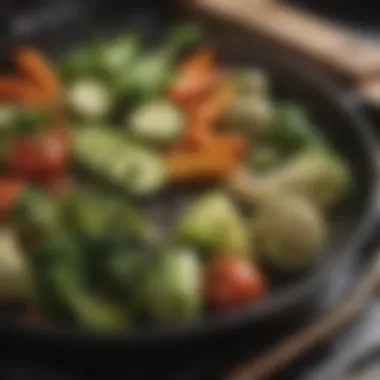

Pairing and Serving Suggestions
In the realm of cooking, the synergy between flavors can elevate a dish from mere sustenance to an experience worth savoring. This section emphasizes the vital role of pairing and serving suggestions in the context of grill pan vegetables. Properly chosen pairings can enhance taste, balance nutrition, and create visually appealing meals. As busy cooks, effective meal design serves dual purposes: expediency in preparation and satisfaction at the dining table.
Complementary Ingredients and Dishes
Complementarity in ingredient selection plays a crucial role when preparing grilled vegetables. Different flavors and textures can create harmony when combined wisely. Here are some options to consider:
- Starches: Foods such as quinoa, couscous, or whole-grain pasta make excellent bases for vegetable medleys.
- Proteins: Grilled chicken or halloumi work well alongside charred vegetables, providing richness while maintaining a light meal.
- Sauces and Dressings: A drizzle of balsamic reduction or tahini dressing can enhance the flavors of the grilled vegetables significantly.
- Fruits: Pairing grilled vegetables with fruits like mango or pomegranate can provide a refreshing contrast.
Moreover, consider serving grilled vegetables atop a bed of leafy greens. This method not only adds nutrition but also benefits the aesthetics of the dish, appealing to the visual senses of diners.
Creative Presentation Ideas
Beyond flavors, the visual aspect of grilled vegetables cannot be overlooked. They deserve attention to make dishes inviting. Here are ways to present them creatively:
- Layering Arrangements: Create tiered stacks featuring colorful vegetables—zucchini, eggplant, and bell peppers—visible in every layer.
- Themed Plating: Consider a Mediterranean theme. Arrange grilled vegetables' patterns to resemble colorful ingredients they share with dishes from that region, such as olives and feta cheese.
- Garnishing: Utilizing fresh herbs like basil or parsley can provide bright color and appealing fragrance to the finished dish.
- Serving Styles: Serve grilled veggies in individual containers with small side cups of dipping sauces to capture a modern feel and offer variety.
Overall, how vegetables are paired and presented can enhance the meal's overall impact on both taste and aesthetics. Remember, a satisfied palate begins with proper pairings, and an appetizing presentation captivates even the busiest of cooks.
Recipes for Busy Cooks: Grill Pan Vegetable Dishes
Grill pan vegetable dishes are key components of efficient cooking for those with packed schedules. They offer substantial benefits, including simplicity and versatility. By incorporating grilled vegetables into meals, busy cooks can quicky enhance flavor and nutrition. The ease of using a grill pan allows anyone, regardless of culinary skill, to produce meals that impress but require minimal prep time. Whether you need a side dish or a main course, these recipes highlight how menu planning can become seamless.
Moreover, grill pans lend a unique smokiness that is often absent in standard cooking techniques. This not only elevates taste but also engages the senses in delightful ways. Using a grill pan effectively maximizes your vegetable intake without overwhelming your schedule, making healthy eating possible.
Simple Grilled Vegetable Medley
A simple grilled vegetable medley embodies ease without sacrificing flavor. This dish can easily integrate varying cooking styles and is highly adaptable based on seasonal produce. Begin with the basics: select vegetables such as zucchini, bell peppers, and asparagus. Each provides distinct textures and tastes, contributing to successful grilling.
Prior to cooking, prepare vegetables by cutting them uniformly. This ensures they cook evenly, avoiding pitfalls of overcooking some pieces while others remain rigid. For flavor enhancement, lightly coat them in olive oil, and sprinkle your choice of salt, pepper, or even garlic powder before placing them on the grill pan.
With the grill pan preheated, arrange vegetables methodically—stop overcrowding to achieve the desired charred marks. Allow to cook until slightly tender, turning when needed. Typically, five to seven minutes serves well. Succinctly, the aesthetic plate and fusion of taste make this dish a go-to for busy cooks seeking simplicity and satisfaction.
Mediterranean Grilled Veggie Wraps
Mediterranean grilled veggie wraps provide a portable meal option that does not compromise on nutrients. This recipe shines through a blend of rich flavors offered by components like eggplant, zucchini, and tomatoes sautéed together within your grill pan. Start with the intial step of marinating, using olive oil mixed with herbs such as oregano or basil for infusion of flavor.
Once marinaded, grill the vegetables as stipulated in the prior section. This step ensures tender results while simultaneously caramelizing some sugars inherent in the produce for added sweetness. Once cooking achieved, assemble your wrap using whole-grain wraps or pitas, filling with a layer of grilled veggies alongside feta cheese or hummus to tie it all together. The minute detail of grilled veggies accentuates the final product, making them perfect lunchtime refereenses.
Grilled Ratatouille in a Grill Pan
Grilled ratatouille packages essence of stewed vegetables, efficiently cooked in grill pan for minimal effort. The mixture clearly brings classic produce such as eggplant, zucchini, bell peppers, and onions into a harmonious blend of color and flavor. Also noted as hearty and picturesque, such a meal ensures great appeal from crossing your table.
Initially, slice and prepare each vegetable uniformly. They cut into bite-sized others allows even grilling and beautiful mixing of flavors. Grill each vegetable separately for optimum char, as they require different cooking times for the best textures. After cooking, combine on a serving platter sprinkled with fresh herbs for a vivid touch. The addition of thyme or parsley will contrast wonderfully against the arrays of colors, while also rounding off each bite.
Before serving, consider integrating balsamic reduction or a drizzle of green olive oil to amplify richness, cementing depth commonly sought in ratatouille. This dish showcases how grilling can deliver delicious meals needing little time within the stated context of busy lifestyles.
Common Mistakes to Avoid When Grilling Vegetables
When searching for delicious flavor and perfect texture in vegetables cooked on a grill pan, avoiding common mistakes is vital. Mistakes can diminish the quality of the dish and may even lead to food that is unappetizing, and unpleasant, and it can frustrate busy cooks looking for efficiency in their kitchen. This section addresses the problematic habits often seen while grilling vegetables and presents functions that will help enhance the cooking experience. By learning these pitfalls, cooks can achieve better results in their meal preparations.
Overcrowding the Pan
One major mistake often made when using a grill pan is overcrowding. When vegetables are packed too closely together, they cannot cook evenly. Heat needs room to circulate effectively, and when crowded, moisture may build up, leading to steaming instead of grilling. The inability to have proper airflow can make the vegetables lose their textural appeal, often resulting in soft or mushy outcomes.
Remember that each vegetable has its individual cooking time and needs its space to develop those desirable char marks and flavor. Instead of placing all vegetables at once, it may be wise to grill them in small batches. This approach benefits both taste and cooking time.
“Grilling vegetables is not just about cooking, it's about creating texture and flavor.”
Cooking times may slightly vary based on the type of vegetable or the size of the pieces. If improper distribution occurs, it may require much more time to achieve the right doneness. Thus, a more mindful strategy encourages not overloading the grill pan.
Ignoring Cooking Times
Precision in cooking time is essential when engaging in grill pan cooking. Ignoring cooking times can transform an otherwise vibrant vegetable dish into something too charred or undercooked. Each type of vegetable has different ideal grilling times.
For example, eggplant typically takes longer than bell peppers. Ignoring these nuances means the meal could end with unevenly cooked meals—this can reduce enjoyment of the end product.
To go the extra step:
- Consider using a timer while grilling.
- Keep an eye on colors shifting and smell.
- Familiarize with individual cooking times per type of vegetable.
Awareness regarding cooking durations help improve not only the dish quality but also assists those busy cooks managing multiple dishes at once.
It's about fine-tuning the grilling process and reflecting on objectives while creating grilled vegetables. Being intentional in controlling cooking times can assure satisfactory results, avoiding waste and disappointment for the care placed in the cooking process.
Cleaning and Maintaining Your Grill Pan
Taking care of your grill pan is key in ensuring that it lasts and performs well over time. Proper cleaning and maintenance enhance the flavor of your vegetables and ensures food safety. Neglecting these duties could lead to a decrease in your grill pan's functionality and ruin your culinary experience. Establishing a routine for care will keep your grill pan in prime condition, extending its life and preserving the flavors you create.
Proper Cleaning Techniques
Cleaning a grill pan isn’t just about washing it; it’s about maintaining its integrity. After each use, let the pan cool slightly but avoid letting it fully cool to room temperature since residues can harden, making it difficult to clean. Use hot water and a gentle sponge or cloth for scrubbing. For stubborn food bits, a wooden or silicone spatula provides an effective and non-scratching option.
- A simple method involves:
- Filling the pan with hot, soapy water.
- Allowing it to soak for about 15 minutes.
- Wiping with a sponge and rinsing thoroughly.
Avoid using steel wool or harsh chemicals, as these can scratch the surface or remove its non-stick properties, thereby impacting its cooking performance. For cast-iron grill pans, seasoning is important too—apply a thin layer of vegetable oil after washing to keep it seasoned.
Longevity Tips for Your Grill Pan
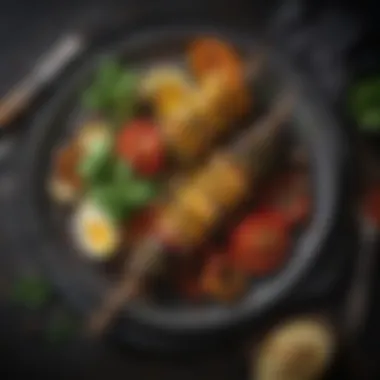

To ensure your grill pan endures the rigors of regular use, consider these best practices:
- Store it Properly: Avoid stacking heavy cookware on top of your grill pan. There is risk of scratches, which can build over time and negatively affect cooking.
- Seasoning: For types like cast iron, seasoning after each use or as needed will maintain its non-stick quality. A simple application of cooking oil works well, rubbed evenly across the pan's surface.
- Avoid High Heat: Many grill pans can withstand high temperatures, but consistent exposure can cause warping or the deterioration of non-stick surfaces. Opt for medium to high heat when cooking to preserve your pan.
- Regular Inspection: Routinely check for debris or signs of wear. Address problems like scratches or rust as soon as possible to minimize future issues.
By following these cleaning and maintenance routines, your grill pan will remain an effective tool in making irresistible grill pan vegetables.
Exploring Advanced Techniques in Grill Pan Cooking
Grill pan cooking goes beyond basic vegetable grilling methods. Advanced techniques allow cooks to maximize flavor and texture and enhance the overall eating experience. Since many busy individuals overlook these methods, this section emphasizes the significance of exploring advanced techniques to create dishes that stand out. The benefits of using advanced techniques are numerous; they improve presentation, strengthen flavors, and can even simplify the overall cooking process.
Combining Different Cooking Methods
To elevate the quality of grilled vegetables, combining grilling with other cooking techniques proves beneficial. Methods like sautéing and roasting can enhance the flavors further and create diverse textures. Here is an overview:
- Grilling and Sautéing: Start by searing vegetables on a grill pan to lock in the rich flavors. Transition to sautéing with garlic and olive oil to impart a deeper taste.
- Grilling and Baking: For heartier vegetables such as eggplant or zucchini, begin with grilling to achieve that distinct char. Finish with baking at lower heat to ensure that they cook through without losing moisture.
- Direct vs Indirect Heat: Using both heat types in one cooking session maximizes control over doneness and reduces chances of burnout. Direct heat helps add the signature grill marks, while indirect heat allows for slower cooking and flavor infusion.
These combined methods underline the flexibility of the grill pan and are essential for achieving a range of textures in the same dish.
Innovative Pairings and Flavors
Creativity in ingredient pairing can reshape the traditional vegetable grilling experience. Here, innovation becomes a part of the everyday cooking style, making familiar dishes exciting.
- Flavor Combinations: Think about unusual matches. Grilling asparagus with citrus zest can deliver a bright freshness. Likewise, toss grilled corn with a sprinkle of cheese and spices to heighten taste.
- Cultural Influences: Culture serves as inspiration for innovative pairings. For instance, combining Mediterranean elements, like feta cheese with grilled peppers, creates not just a meal but an experience.
- Sauces and Glazes: Consider drizzling Balsamic reduction or tahini sauce over grilled vegetables. This method not only adds moisture but also contributes different flavor layers, enticing the palate further.
Building awareness of methods like these expands dish possibilities. Therefore, advanced techniques, including the combination of grilling with other cooking styles, alongside identifying imaginative pairing ideas, allow busy cooks to navigate their flavor landscapes confidently.
Seasonal Vegetable Considerations
Grill pan cooking enables busy cooks to create flavorful dishes quickly. Knowing which vegetables to grill throughout the seasons can enhance the culinary experience significantly. Seasonal vegetable selections create fresh flavors, nutritional benefits, and cost savings. Choosing vegetables that are in season often leads to better taste and helps support local farmers. They are typically fresher, more flavorful, and often less expensive than off-season options. Seasonal considerations also contribute to an environmentally friendly cooking approach by reducing transport and storage needs.
Vegetables by Season
To optimize taste, understand the vegetables available in each season. Here is a concise breakdown of seasonal vegetables:
- Spring:
- Summer:
- Fall:
- Winter:
- Asparagus
- Artichokes
- Radishes
- Peas
- Spinach
- Bell Peppers
- Zucchini
- Eggplant
- Tomatoes
- Corn
- Butternut Squash
- Brussels Sprouts
- Cauliflower
- Kale
- Sweet Potatoes
- Carrots
- Cabbage
- Beets
- Turnips
- Parsnips
Culinary interest need not decrease with the changing weather; rather, cooking styles may shift with each season, that underscores kitchen creativity. Seasonal selection aids in utilizing flavors best adapted to the time of cooking.
Adjusting Techniques for Seasonal Variations
Utilizing seasonal vegetables also means adapting your methods when grilling. Different types of vegetables have varied characteristics that need attention. Here are some techniques for seasonal adjustments:
- Spring and Summer Vegetables:
Bursts of sugary flavors emerge during these seasons. Grill pans require moderate heat to retain crisp textures when cooking vegetables such as asparagus or zucchini. For robust summer tomatoes, consider shorter grilling times. - Fall and Winter Vegetables:
These vegetables tend to be heartier and often require longer cooking times to break down fibers. For butternut squash, cut into smaller uniform pieces to enable even cooking.
It is important to understand how different vegetables react to heat. For example, softer vegetables might do well with quick searing, while root vegetables need a longer time at low heat for optimal flavor release. Adjusting these techniques ensures successful grilling every time, respecting the vegetables' natural qualities.
Consider cooking on moderate heat for fresh vegetables, while heartier, denser choices favor lower settings.
By being aware of seasonal options and modifying grilling techniques, your dishes can continue vibrant and interesting throughout the year while fitting seamlessly into a demanding schedule.
The Nutritional Benefits of Grilled Vegetables
Grilling vegetables is not just a culinary technique; it offers distinct nutritional benefits that can enhance a cook's dietary choices. For busy individuals, understanding these benefits fosters healthier meal decisions that fit into hectic lifestyles. This section delves into how grilling preserves vital nutrients in vegetables and how incorporating them aligns with various dietary goals.
Retaining Nutrients Through Grilling
When vegetables are grilled, they often retain a higher level of essential nutrients compared to other methods of cooking. The process of grilling typically involves shorter cooking times and uses dry heat, which helps keep vitamins and minerals intact. Here are some key points to consider:
- Water-Soluble Vitamins: Grilling minimizes the exposure of vegetables to water, allowing for better retention of water-soluble vitamins such as vitamin C and certain B vitamins.
- Antioxidant Properties: Grilled vegetables can enhance antioxidant compounds like carotenoids and flavonoids. These compounds have a range of health benefits, including anti-inflammatory effects and promoting overall wellness.
- Flavor Enhancement: Grilling vegetables can catalyze a process called Maillard Reaction, giving a unique flavor while also trapping nutritional content. Flavorful meals are an important part of maintaining a balanced diet.
Grilled Vegetables and Dietary Goals
Integrating grilled vegetables into one’s diet contributes significantly to achieving various dietary goals. For many, the objective includes the need to eat more plant-based options or to reduce calorie intake while maximizing nutrient density. Consider these aspects:
- High Nutrient Density: Grilled vegetables typically provide numerous vitamins, minerals, and antioxidants with minimal calories. This is especially beneficial for individuals managing weight.
- Plant-Based Diets: For those aiming to eat more plant based, grilled vegetables can become staples in various meals. They’re excellent in salads, wraps, and as side dishes to protein choices.
- Managing Health Conditions: People with dietary restrictions often benefit from understanding how grilled vegetables can contribute to their overall health. For instance, users looking for low glycemic options or lower-fat cooking methods can find grilled options especially useful.
Incorporating grilled vegetables into meals supports not just varied cuisines but also embraces health-centric lifestyles. By focusing on technique and quality ingredients, one enhances both flavor and nutritional value in daily cooking. This can have profound benefits for individuals seeking genuine, energy-boosting, and nutritious foods amid a busy life.
Closure: Simplifying Your Cooking Experience
In the context of this article, the significance of simplifiyng your cooking experience, particularly through grill pan vegetables, cannot be overstated. The narrative revolves around creating flavorful and healthy meals without the need for extensive culinary training or time-consuming preparations. The techniques discussed aid busy cooks in making efficient choices that lead to nutritious outcomes.
By using a grill pan, individuals can utilize a multi-functional tool that enhances both the cooking process and the flavor profile of various vegetables. The convenience of grill pans appeals to those with hectic schedules, such as families or working professionals, who may find themselves challenged to make quality meals within limited time slots.
It's important to recognize several key benefits when embracing this cooking style. Firstly, the methods showcase how to elevate vegetables from mere side dishes to main attractions on a plate. Secondly, various techniques empower cooks to develop their personal flair while offering flexibility in cooking styles. Seasonal considerations stress the importance of seasonal vegetables, promoting their usage and allowing for continued freshness throughout the year.
Efficient yet simple cooking approaches become increasingly vital in today's fast-paced environment. Grilling vegetables in a pan allows for quicker preparation as well as minimal clean-up, perfect for a busy cook.
"Embracing efficient cooking methods can lead to more enjoyable dining experiences and improved health for individuals and families alike."
Recognizing the vitality of meal planning enhances this simplicity. Integrating grilled vegetables into daily meal cycles creates opportunities for creativity while retaining ease. Through weekly vegetable selections and pre-preparation, cooking can transition from a strenuous chore to a rewarding and pleasurable activity.
Embracing Grill Pan Vegetables for a Busy Lifestyle
Adopting grill pan vegetables is about more than just speed; it embodies lifestyle enhancements for modern-day cooks. The practical use of equipment allows the transformation of everyday vegetables into splendid meals with very little effort. Each recipe offered within the article provides a framework and variation of preparation possibilities that invite exploration and simplicity.
This approach elevates even the most basic ingredients. Adding different marinades or experimenting with combinations of spices leads to variety in one’s weekly meal plans while ensuring that cooking remains enjoyable rather than burdensome. During hurried weekdays, a well-stocked fridge of grill-friendly vegetables can prove invaluable.
Key elements to keep in mind include:
- Selecting seasonal produce to maximize freshness and nutrients.
- Planning ahead with direrct veggie choices to reflect seasonal availability.
- Marinating beforehand to save time on cooking days.
- Simplifying side dishes by integrating grilled vegetables directly into main courses.







